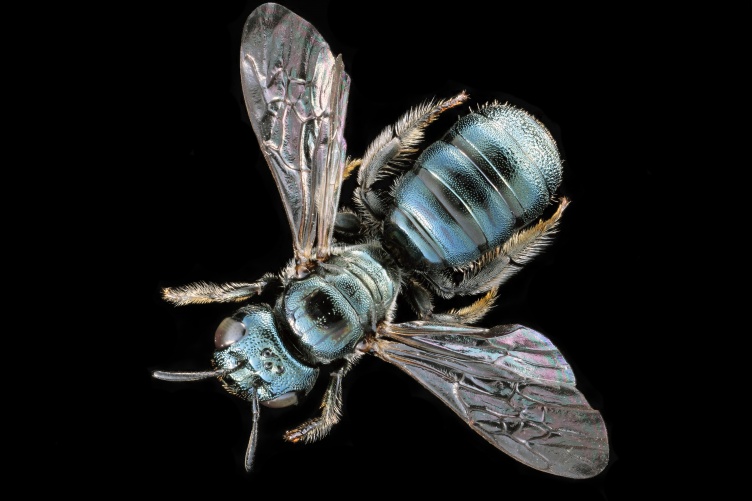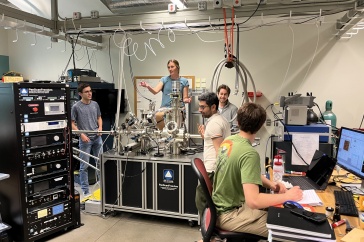
Researchers studied the North American small carpenter bee, Ceratina calcarata, to learn more about how honeybees evolved their complex social lives. Photo by Cullen Franchino '16.
The complex social life of honeybees — with their queens and workers cooperating to produce honey — is deeply entrenched in public imagination. But the majority of the more than 20,000 bee species are solitary: One female mates, gathers provisions, lays eggs and walls them up with food in a secure spot. Recent UNH research into a mostly solitary species that has some social behaviors, the North American carpenter bee, advances understanding of the evolutionary shift from honeybees’ loner ancestors to the social beings they are now.
“We know that the honeybees of today evolved from solitary ancestors but we’re still figuring out what biological factors may have contributed to that gradual process,” says Wyatt Shell, a Ph.D. student in biological sciences and lead author of the study, published in Proceedings of the Royal Society B as its cover story.

The subject of Shell’s study, the North American small carpenter bee (Ceratina calcarata), has incipient, or simple, sociality. “For example, instead of departing the nest after laying her eggs, a mother may guard her brood while being supported by just a single working daughter,” says Shell. The incipiently social bee can serve as a stand-in for ancestors of honeybees and other more socially complex bees.
Comparing relative brain gene expression levels of one individual C. calcarata to the next, Shell and co-author Sandra Rehan (formerly at UNH and now an assistant professor at York University in Canada) examined which genes might be associated with traits of foraging (visiting flowers to collect pollen and nectar) and guarding (sitting at the nest entrance to prevent predation or parasitism). Those traits are simultaneously demonstrated by a mother bee and one of her daughters during the early autumn, giving the researchers an opportunity to explore the effects of maturation — from prereproductive daughters to post-reproductive mothers — on gene expression.
“Hopefully, the better we understand the biological stories of our many wild bees, the better we will be able to protect them.”
The researchers found that this early autumn nest environment may strongly affect brain gene expression in C. calcarata. “This provides empirical support for the idea that even transient and relatively simple social environments can be elements of great evolutionary consequence for a lineage,” Shell says.
The study also found that genes associated with foraging and guarding in C. calcarata include those that are associated with the same roles in other social insects such as honeybees. “This is exciting and intriguing because it supports the theory that such ‘conserved’ genes may play a relatively consistent and important role in the evolution of sociality across bees, ants and wasps,” Shell says.
Rehan calls C. calcarata and other wild bees the “unsung heroes of the pollinator world,” yet like other bees, they’re in decline.
“While species like C. calcarata are thankfully gaining some public attention,” says Shell, “most folks are still unfamiliar with their biology. This just speaks to the pressing need for similar studies in other incipiently social bees: Hopefully, the better we understand the biological stories of our many wild bees, the better we will be able to protect them.”
This work was supported by funding from the National Science Foundation (IOS-1456296) and an NSF Graduate Research Fellowship (1450271) to Shell.
-
Written By:
Beth Potier | UNH Marketing | beth.potier@unh.edu | 2-1566

















































